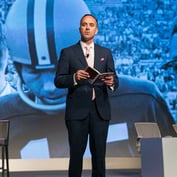Members of the Financial Stability Oversight Council (FSOC) voted unanimously Tuesday to free Prudential Financial Inc. from a complicated, costly extra layer of federal oversight.
FSOC agreed to rescind an earlier move to classify the Newark, New Jersey-based company as a nonbank “systemically important financial institution,” or SIFI.
(Related: Prudential May Be Close to Shedding ‘Too-Big-to-Fail’ Label)
Prudential was the last company designated as a nonbank SIFI.
The four other companies that have received nonbank SIFI designations — American International Group Inc., MetLife Inc., American International Group Inc. (AIG), and General Electric Company’s finance company — have already escaped from nonbank financial company status.
FSOC has now steered the company away from a regulatory approach policymakers in Washington developed in response to the 2007-2009 Great Recession.
But FSOC officials note in a report explaining the Prudential decision that they believe the failure of a company the size of Prudential could cause serious problems for customers and state insurance guaranty associations, even if it would be unlikely for those problems to destabilize the U.S. financial system.
What is FSOC?
In the 1990s and early 2000s, financial services companies created many securities backed by pools of home mortgage loans. The mortgage-backed securities issuers and purchasers assumed that home usually made their mortgage payments, and that, if home buyers did default, lenders could get most or all of their money back by taking back and selling the homes.
Around 2007, interest rate locks came off many adjustable-rate mortgages. Large numbers of mortgage borrowers defaulted. Housing prices in many communities fell.
Bear Stearns Companies Inc., a large investment bank, failed in March 2008. Lehman Brothers Inc., another investment bank, failed in September 2008.
In September 2008, AIG sought help from the Federal Reserve System with resolving problems at a non-insurance-company unit in London. The unit had provided “credit default obligations” (CDOs) or arrangements designed to pay cash to purchasers when mortgage-backed securities defaulted. The CDOs exposed AIG to billions of dollars in calls for collateral, or pools of cash used to back the CDO obligations, at a time when paralysis in the credit markets blocked AIG’s access to cash.
For a few weeks in October 2008, rumors circulated that the crisis could lead to a meltdown of the banking system.
Members of Congress drafted the Dodd-Frank Wall Street Reform and Consumer Protection Act based on the principle that the financial crisis had happened partly because federal regulators had paid too little attention to the risks that had been building up outside the banking sector.
Dodd-Frank called for the creation of FSOC, to provide a body that would help federal regulators monitor the entire financial system and cope with any severe threats. By law, the Treasury secretary is the chairman of FSOC. The council also has nine other voting members, including the chairman of the Federal Reserve, the chairman of the U.S. Securities and Exchange Commission, the chairman of the Federal Deposit Insurance Corp., and an independent member with insurance expertise.
Why have life insurers objected to FSOC oversight?
Prudential and other life insurers have argued, both in the United States and in international forums, that most systemic risk fighters have focused too much on coping with potential runs on banks.
(Related: Why Variable Annuities Scare a Fed Economist)
For banks, the biggest risk is that customers will rush in and pull out all of their money immediately, life insurers have said.
Life insurance policies and annuity contracts are different, insurers say, because life insurers already have big pools of reserves backing their obligations, and because the products are generally designed in such a way that the holders have only a limited ability to pull cash out quickly.
Life insurers say FSOC efforts to increase companies’ liquidity interfere with life insurers’ need to make long-term investments to support claims that might arrive decades in the future, and benefits periods that may last for decades.
Life insurers have also argued that, in practice, FSOC requirements have been confusing, and difficult and costly to meet.
What is Prudential saying about the FSOC move?
Prudential said today that it’s pleased by FSOC’s decision to rescind Prudential’s designation as a nonbank SIFI.
“We are pleased with this decision, which affirms our longstanding belief that Prudential never met the standard for designation,” the company said. “This outcome reflects Prudential’s sustainable business model, capital strength and comprehensive risk management, which have and continue to enable us to fulfill our promises to our customers, deliver consistent performance and meet regulatory obligations.”
Prudential said it will continue to work with regulators on measures to help address potential threats to financial stability.
The company noted that the New Jersey Department of Banking and Insurance is its group-wide supervisor.
What has the American Council of Life Insurers said about the FSOC move?
Susan Neely, the new president of the American Council of Life Insurers (ACLI), put out a statement welcoming the cancellation of Prudential’s nonbank SIFI designation.
“The inappropriate designation of Prudential Financial was the outcome of a flawed process that demonstrated a lack of understanding of the insurance business model and ignored state insurance regulators’ effective oversight of the life insurance industry,” Neely said. “Life insurers are sources of financial stability in the economy, not systemic risk. Their enduring promises and long-term investment philosophy provide a shock absorber for the economy in times of stress.”
FSOC should focus, instead, on assessing major threats to U.S. financial stability and working with primary financial regulators to address those threats, rather than pursuing a “designate-first approach,” Neely said.
What does FSOC say about the possible effects of a Prudential failure in its Prudential report?
FSOC has posted a redacted copy of the report summarizing its views on Prudential here.
FSOC officials have concluded that the failure of Prudential would be unlikely to bring down the U.S. financial system.
But officials have also concluded that, if Prudential did fail, its failure could cause big problems for securities lending counterparties and derivatives counterparties.
FSOC officials write in more detail about the possible effects of a Prudential failure on the state guaranty associations.
1. Guaranty association primer
In most states, a guaranty association is a group that includes all of the insurers in a designated market sector, or group of sectors. The association is supposed to help make good on an insolvent member’s insurance obligations, up to statutory limits.
The insurers in the association do not pay large association dues or premiums on an ongoing basis. Instead, when an association member fails, the surviving insurers pay assessments.
2. 2% assessment cap
Most cap the annual assessments at 2% of an insurer’s annual premium volume, officials say.
If an association ends up with too little cash to pay all of the covered obligations of a failed insurer immediately, then the association will pay those additional obligations off over time, officials say.
The 2% cap could force life insurance beneficiaries and annuity users to wait longer than expected for their payments, but it can also keep guaranty association obligations for a failed insurer from killing the other insurers, officials say.
Officials add that guaranty associations maintain credit facilities and can use those facilities to borrow money.
3. Guaranty association annuity assessment capacity
FSOC officials have hidden most of the guaranty associations’ Prudential exposure numbers in the public version of the report.
Officials do talk about what would happen in 10 states in which Prudential has a large amount of annuity exposure, if Prudential failed, and if the amount of assets available was 15% lower than the annuity obligations.
“The obligations of the 10 GAs with the largest annuities exposures would range from [•] to [•] times their annual assessment obligations,” officials say.
However, given the long-term nature of Prudential’s products, it’s unlikely the obligations would come due in a single year, officials say.
4. Guaranty association life insurance assessment capacity
Officials do not hint at what the guaranty associations’ exposure to Prudential’s life insurance obligations would be.
Officials do say that, in 2016, the nationwide annual assessment capacity of the life guaranty association was $3.2 billion.
What about runs on insurers?
Officials observe that, even though struggling life insurers may not face the same kinds of rapid runs as struggling banks, a struggling life insurer could face an increase in product surrenders.
An increase in surrenders could force an insurer to liquidate assets quickly, officials say.
But FSOC analysis “indicates that there is not a significant risk that asset liquidation by Prudential would disrupt trading or funding in key markets or cause significant losses or funding problems with other firms with similar holdings to an extent that would materially increase borrowers’ costs of funds,” officials say.
— Read What Agents Need to Know About the Penn Treaty Liquidation, on ThinkAdvisor.
— Connect with ThinkAdvisor Life/Health on LinkedIn and Twitter.







 October 17, 2018 at 01:27 PM
October 17, 2018 at 01:27 PM















 Slideshow
Slideshow





